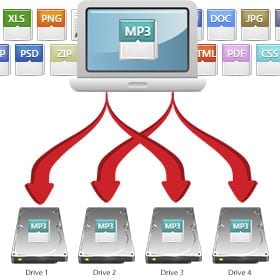 No, not the bug spray. The RAID I’m talking about is a hard drive RAID or a Redundant Array of Independent Disks. As crazy as the name sounds, this is essentially a type of storage solution that combines multiple hard drives into a cohesive system that appears to the computer as a single hard drive. Depending on the setup, this can afford increased speed, storage capacity, backup solutions, or a combination of each of these.
No, not the bug spray. The RAID I’m talking about is a hard drive RAID or a Redundant Array of Independent Disks. As crazy as the name sounds, this is essentially a type of storage solution that combines multiple hard drives into a cohesive system that appears to the computer as a single hard drive. Depending on the setup, this can afford increased speed, storage capacity, backup solutions, or a combination of each of these.
There are four RAID configurations seen most often in the wild:
- RAID 0
- RAID 1
- RAID 0+1 or 10
- RAID 5
Each of these are similar in that they work across multiple drives, but each have their own merits that benefit specific applications in the real world.
RAID 0
RAID 0 is referred to as striping and is a setup in which data is written across two hard drives. Let’s take a 500 MB video file. The computer takes the file and splits it in half, 250 MB is written on drive 1 and 250 MB is written on drive 2. When you try to access the file, the computer requests the file from each drive and uses it as if it were on a single drive. Since there is two drives involved in this process there is an increase in read and write speeds because each drive is independently reading and writing the files for the OS.
With a single drive you are limited to the speed that specific drive can read and write, with two you are limited to the combined speed the two of them can reach independently. The only downside with this setup is that if one drive fails the files are rendered useless because each drive holds half of the data. In short terms, “ALWAYS HAVE A BACKUP!”.
RAID 1
Now RAID 1 is the opposite, and is referred to as mirroring, and as the name implies, data is wholly written on each drive, creating a mirrored copy of everything. The same 500 MB file is fully written on drive 1 and drive 2. Very much like a separate backup, if one drive fails there is an exact copy that can be used immediately.
RAID 0+1 or RAID 10
RAID 0+1 or RAID 10 is a combination of these first two; both require a minimum of four drives. In RAID 0+1 there are two RAID 0s that mirror each other while RAID 10 is two striped RAID 1s. Essentially, the same 500 MB file is fully written twice, each time across two drives. The first 250MB on drives 1 and 3 and the second 250MB on drives 2 and 4. This gives the user the same speed increase as RAID 0 with the added benefit of having a mirror or backup of the same data. Just like RAID 1, any drive can fail and there is another copy waiting to be used immediately.
RAID 5
RAID 5 is the most complex of these setups in how it works, but many people see it as being the best of all the worlds. It provides speed, data security, and a failsafe in case a drive fails. Requiring only three drives, this setup is slightly more cost effective than RAID 10, while still providing the backup element in case of a drive failure.
The simplest way to explain its operation is to imagine that the same 500MB file is split in half and written across drives 1 and 2. The parts are then calculated into a formula, which is stored on drive 3, so that if drive 1 or 2 fails the information can be used to recreate the missing part of the data. The next file then is written across drives 2 and 3 with the formula stored on drive 1, and so forth. This RAID setup acts like a RAID 0 in that files are spread across drives, but gives the security of a RAID 1 and provides a fault-tolerance for drive failure.
Do you need RAID?
Whether or not you need a RAID setup is based in your workflow. If you work with large files such as raw photos, video editing or music production, or simply if most of your files are stored on an external hard drive, you can most likely benefit from the speed and security RAID offers. Often a speed boost is exactly what you need to get your work done more efficiently and the seamless integration of a RAID solution is a perfect addition to any current setup.
While you can go about setting up a RAID system on your own, OWC has a number of preconfigured solutions from the Elite Pro Dual systems and the Qx2 to the Guardian Maximus and Maximus mini. There is any size and any speed available for any application.
RAID Hard Drives versus going SSD
Of course if you’re RAIDing hard drives together for speed you do have another option with SSDs. A single 6G OWC SSD can go as fast as 4 hard drives RAIDed together. So before you plunk that hard earned cash down a hard drive based performance RAID 0 array, you might want to check out some SSD options as well. Heck, 2 OWC SSDs RAIDed together can go as fast as 8 hard drives in a RAID 0. Now that’s fast!
Check them out to see what fits and happy RAIDing!
Editor’s Note: Just like your favorite breakfast cereal, RAID solutions are part of a complete backup plan – not the entire solution. For complete details see: Take it from a Tech: RAID ≠ Proper Backup & Back Up Your Data & Save A Squirrel








My spouse and i were really thankful Emmanuel could conclude his inquiry via the precious recommendations he got through the web page. It’s not at all simplistic to just choose to be releasing helpful tips which others have been making money from. Therefore we already know we’ve got you to be grateful to for this. The type of illustrations you made, the straightforward web site navigation, the friendships you will give support to engender – it’s everything extraordinary, and it’s assisting our son and the family recognize that this idea is excellent, and that is exceptionally essential. Many thanks for all the pieces!
Just set up my Qx2 w/4 honkin’ big 4TB HGST enterprise drives, RAID 5 using 3 + 1. So long as drives A, B, and C are healthy, is drive D just spinning away doing “nothing” (no read/writes) other than waiting to be called into service if one of the others fails?
You are correct, the D drive will just be spinning there waiting for a drive to fail before it is put to use.
Speaking on behalf of D drive, I’d say “That’s easy living!”
RAID 6 is becoming more common on various devices that do support RAID – can handle 2 drive failures instead of 1, but does require 4 drives minimum.
and for ZFS there is RAIDZ2
What about the SPAN option that OWC also offers as an option on RAID boxes.
Similar to RAID 0 but different. :-)
MacRat – that SPAN option might be the same as JBOD (Just a Bunch Of Disks)
Several drives appear as a single drive with a capacity of the total of all the disks.
a file is written to one drive instead of being split across several disks like it would with RAID 0.
“a file is written to one drive instead of being split across several disks like it would with RAID 0”
That is the key information that should be better documented! :-)
Thanks!